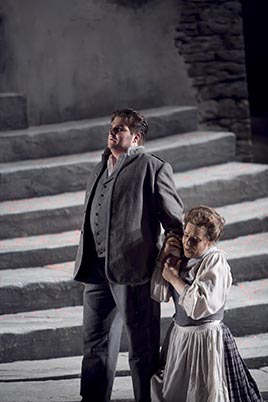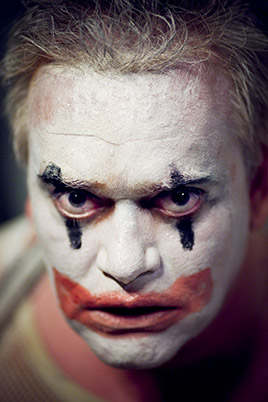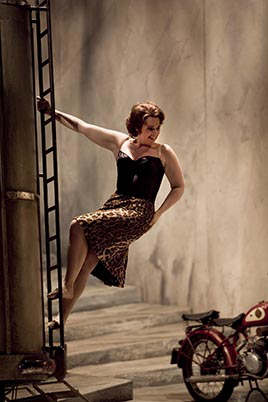|
Editorial Board
Melanie
Eskenazi
Webmaster: Len Mullenger
|
Seen and Heard International
Opera Review
Mascagni: Cavalleria rusticana and Leoncavallo: Pagliacci Stockholm Royal Opera, Pier Giorgio Morandi (conducto) 02.09.2006 (GF)
Directed by Knut Hendriksen Sets and Costumes: Isabella Bywater Lighting: Kurt Larsson Musical Direction: Pier Giorgio Morandi
Casts: Cavalleria rusticana Emma Vetter (soprano) – Santuzza Michael Weinius (tenor) – Turiddu Agneta Lundgren (soprano) – Lucia Tord Wallström (baritone) – Alfio Katarina N. Leoson (mezzo-soprano) – Lola
Pagliacci Magnus Kühle (tenor) – Canio (Pagliaccio) Sara Olsson (soprano) – Nedda (Colombina) Gunnar Lundberg (baritone) – Tonio (Taddeo) Jonas Degerfeldt (tenor) – Peppe (Arlecchino) Ola Eliasson (baritone) – Silvio Jan-Ola Persson and Wieslaw Majczuk – Two villagers
The Royal Opera Chorus Children’s Chorus from Adolf Fredrik’s Music School The Royal Opera Orchestra
Tradition has it, nowadays, that these two war-horses from the verismo school are performed together as a double bill, but that has probably been truer about recordings of them than actual performances. As a matter of fact, when this production was first mounted in Stockholm fourteen years ago it was the first time they appeared together there. The reason, says Chief Dramaturge Stefan Johansson in the programme booklet, is that most of the one-acters or other short operas suitable to combine with either of these two have come out of fashion. But of course there are connections between them: the geographical setting, the dramatic action with raw emotions and partly rather crude music, the theme of jealousy and unfaithfulness and also the religious motifs that Hendriksen has put in the forefront; so much so that before the curtain rises for Cavalleria rusticana the crucified Christ can be seen at the front of the stage, where he remains until he is brought into the church for the Easter Mass.
Hendriksen and his set designer Isabella Bywater have cleverly set the two operas in the same old Sicilian village, Cavalleria in the 1890s, the period when it was first performed, Pagliacci ca. sixty years later. These are not spectacular sets and there are no spectacular colours. The stage is mainly filled with quite steep stairs, in the centre the church, leaning and cracked through centuries of earthquakes, to the right Mamma Lucia’s tavern. White and grey are the dominating colours, only Lola stands out in her luxurious red dress, the embodiment of sin. In this shabby environment the cruel action unfolds with implacable consistency. The primitive emotions are exposed straightforwardly: Turiddu’s overwhelming lust for Lola and his hot-tempered, even violent disposition, Lola’s playful teasing, actually more theatrical than truly emotional, the honest Alfio’s almost paralyzing insight, when he realises that he has been cuckolded, the loving Santuzza, who yearns to get everything right but in her despair becomes the triggering factor for the tragic end, and finally Mamma Lucia who is loving and blind for what is taking place in front of her eyes – all this is laid bare in a punchy performance, where Pier Giorgio Morandi never misses a chance to underline the crude course of events through knock-out playing by the orchestra, seemingly on top form.
This is no filigree etching but a large canvas with primers put on in broad brush strokes. Other conductors, notably Karajan on his legendary DG recording, have told us that there is more to this score but to make the full effect it needs to be played for all its worth – or not at all. And Morandi exposes the lyrical moments, the resting points. The prelude has the romantic surge in the strings, Turiddo’s off-stage (actually a mite too off-stage) declaration of love to Lola with its harp accompaniment is atmospheric, the church scene lends a feeling of repose and solemnity to the events and the celebrated Intermezzo is played lightly, airily, breathing faster than usually, as if he wants to tell us that after the agitated proceedings that have just been exposed to us, the hearts of the main protagonists are still beating faster. It must be said at this point that the chorus is magnificent all through the opera, not only as Easter Morning church visitors but also in the more profane moments, even though the drinking scene, dominated by Turiddu’s outgoing joy, feels a bit pale – not the singing but the acting – but probably Hendriksen wants to say that the villagers have already understood that something terrible is going to happen.
The singers are deeply involved in their roles and the singing, at least by the two main protagonists, is something to rejoice in. Michael Weinius, who recently changed from baritone to tenor, seems to be that rare thing we have been waiting for ever since Sonny Wallentin twenty years ago appeared seemingly from nowhere: a home-grown lirico-spinto tenor with a rounded, full Italianate voice, powerful and slightly baritonal, with a ringing top and added to this an ability and willingness to scale down and show that this thick-skinned character has a heart, most telling in his final words to his mother when he too belatedly has realised what he has done. Weinius was a good baritone, as a tenor he seems to be great.
No less impressive is the young Emma Vetter as Santuzza. This is indeed a great voice with a dramatic potential that points to Tosca and maybe even Turandot and, in a distant future – hopefully not too early – the Wagner heroines. A gleaming top with seemingly limitless powers and, like Weinius, a lyrical side that is ravishing and deeply touching.
Katarina N. Leoson makes much of little as Lola while both Agneta Lundgren and Tord Wallström are beginning to show their age. Wallström has been a pillar of strength for many years now, with a rock-steady, dark-timbred voice that seemed indefatigable. Voice-crackers like Telramund and Boris Godunov were no obstacles to him in the past. He still, though, has his imposing stage presence and with his big moustache he looks quite like Ruggero Leoncavallo who has popped in for a guest appearance in his composer-colleague’s opera.
In Cavalleria rusticana the amorous affairs, and also the killing, take place off-stage; in Pagliacci all this happens before the viewers’ eyes and the pivot of the proceedings is Nedda, played with lusty sexual allure by Sara Olsson in leopard patterned skirt and plunging neckline. The two leading male characters, Canio and Tonio, have been entrusted to Magnus Kühle and Gunnar Lundberg, two well-versed character-singers who may lack the ultimate traditional Italianate roundness of tone and, in the case of Kühle, the sheer volume we have got used to through myriad of recordings, from Caruso and onward. The loss in beauty is however more than compensated by the deep involvement and identification and Kühle’s Vesti la giubba is an immensely touching portrait of despair and resignation, just as when he in the concluding commedia dell’arte scene rips open his costume, bares his breast – thus definitely leaving his role as Pagliaccio – and sings No, Pagliaccio non son with vehement intensity. Lundberg sets the stage through his well characterised prologue, employing a wide register of nuances in a detailed reading of this show-piece. Not always note-perfect and horribly out of tune in one place this was still a reading that stayed in the memory long afterwards.
Sara Olsson, spending quite some time on top of the wagon, sings a fine “bird aria” but is even better in the long duet with Silvio, which I have always regarded as the musical high-spot in this opera. Like the intermezzo in Cavalleria rusticana this is also a moment of repose from the violent emotions surrounding it and it seems that Leoncavallo was inspired to give of his best with a lyric inspiration that is rare but can be found in some of his best songs. Canio’s Un tal gioco in the beginning of the first act is another such moment. In the duet we also hear by far the best baritone singing during the afternoon from Ola Eliasson, whose youthful voice, delivered with steady tone and melting bel canto, promises much for the future. Jonas Degerfeldt not only displays some impressive gymnastic prowess but has developed into a good actor and he sings Arlecchino’s serenade stylishly and with a ringing final note.
As in the companion piece Morandi went for punch and drama but he also highlighted some exquisite instrumental touches in the beginning of the prologue, where Leoncavallo uses the woodwind to good effect and the intermezzo between the two acts with its quotations from both the prologue and Canio’s Vesti la giubba was turned into a miniature symphonic poem.
Showing ordinary people of flesh and blood in situations of decisive importance was the aim of both Mascagni and Leoncavallo and these performances in Stockholm never let the intensity slacken.
Back to the Top Back to the Index Page |
| ||
|
||||






